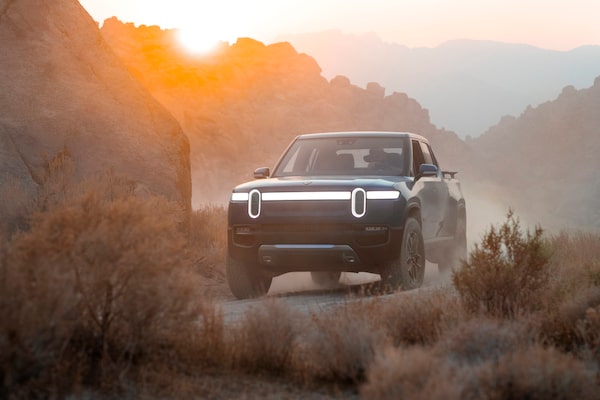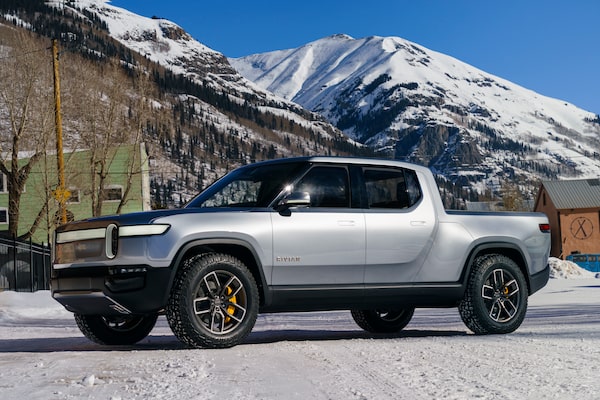
The Rivian R1T recently became the first all-electric vehicle to complete the Rebelle Rally.Courtesy of manufacturer
“This whole thing was a giant experiment,” said Emme Hall, off-road racer and auto journalist. “We went into the dunes with an attitude of, ‘Letʼs just see what happens.’” What happened was that Hall and navigator Rebecca Donaghe, who spent eight days crossing 2,000 kilometres of desert under gruelling conditions, became the first team to complete the Rebelle Rally in an all-electric vehicle.
Their preproduction Rivian R1T finished sixth overall, despite being unmodified for off-road use.
Now in its fifth year, the Rebelle Rally is a female-only off-road navigation competition that takes place in the rocky, dusty deserts of California and Nevada. As opposed to the outright speed of the Baja 1000, a brutal 1,000-mile off-road race held in northern Mexico, the Rebelle requires careful planning. Only maps and a compass are allowed to plot a course across empty spaces and jagged rocks, scoring points by sticking to a challenging course. This year’s rally was held in early October.
Hall has won the event twice, but completing the course in an unproven electric-powered pickup gave her pause. “We didnʼt know what our range would be out in the desert,” she said. Not only could temperatures above 45 C sap battery power, but soft sand, slow travel over rocky terrain, and releasing some air from the tires for added grip would all deplete battery life.
However, the Rivian R1T proved up to the task. Closer to a production unit than a prototype, the R1T used by Hall and Donaghe wore standard Pirelli Scorpion tires and rode on a stock air suspension. It carried just shy of 275 kilograms of extra gear and spare parts, but nothing outside of what a conventional combustion-engine-powered competitor would bring: spare tires and wheels, rope, camping gear, water, tools and a jack.
When it goes on sale in June of 2021 (November in the Canadian market), the R1T will come with up to a 180-kWh battery, good for a claimed 640 kilometres. Hall and Donaghe used a truck fitted with the smaller 135-kWh battery, and, as a preproduction unit, it was further limited to only about 75 per cent of expected production capacity. On flat ground, that’s about 380 kilometres.
But in the Rebelle Rally, flat ground is hard to find. Rivian was taking a risk; if the team ended up stranded in the desert, that could be a publicity-damaging failure. A team of mechanics would accompany the effort, along with as many spare parts as could be carried, but putting the R1T into the hands of a Rebelle Rally team was a gamble.
For Hall, course completion was the goal, but so, too, was a chance to evaluate the benefits and drawbacks of electric power in her favourite terrain. If the R1T went the distance, it would be the first production battery-powered machine to do so. If it fell short, thereʼd still be a story to tell.
If the R1T was going to get to the finish, it needed to have a useful off-road range. Despite rough terrain, rock crawling and power-sapping dunes, the R1T team saw a respectable average of 270 kilometres of range over eight days. While other teams refuelled and repaired overnight, the R1T was recharged using a mobile charger from Power Innovations. Capable of providing 130 kW of charging, this mobile station charged the R1Tʼs battery to 80 per cent in 30 minutes, and to 100 per cent in an hour.
Further, the R1Tʼs design and electric power gave it advantages over the Jeep Wrangler Rubicon with which Hallʼs team won the 2018 Rebelle Rally. Its fully independent suspension was a great deal more comfortable than the Jeepʼs twin live axles, she said. According to Hall, the Jeepʼs simpler setup does allow for better articulation, or individual wheel travel, useful in rock-crawling. However, the R1Tʼs adjustable air suspension was also unfazed by difficult sections, with excellent clearance.


The R1T's adjustable air suspension and instant torque helped make it through difficult terrain.Courtesy of manufacturer
Electric torque proved itself off-road as well. Combustion-engine four-by-four vehicles need the extra-low gearing of a low-range gearbox to harness torque for low-speed climbing. Rivianʼs R1T comes with a colossal 826 lb-ft of grunt on offer, all of it instantly available. Hall said the R1T was the first production vehicle she was able to drive to the top of Oldsmobile Hill, a steep and slippery dune near Glamis, Calif.
Rivianʼs electric powertrain proved robust, which paid off as well. Because the Rebelle is a points-based rally, teams lose points depending on how long a repair takes and whether the parts are carried on board the truck itself or by a supply vehicle.
The team decided to carry mechanical spares on the R1T and electrical components in the support vehicle, so when the R1T bent a rear control arm over a high-speed, bumpy section, the replacement was on hand and took under two hours to swap out. No points deducted.
Peter Herath, one of two engineers Rivian sent as support staff to fix the R1T, instead found himself largely working on competitorsʼ vehicles, everything from Jeeps to G-Class Mercedes. According to the rules of the Rebelle, any mechanic support staff are available on a first-come, first-served basis to any team, and the R1T didnʼt need much help.
“It turned out to be a great way to see how [other] people set up their vehicles,” Herath said. “It was also great to see how people were really accepting and curious about the R1T. The rally had a huge sense of camaraderie.” Herath added that Rivian used data gathered over the rally for upcoming improvements. The next R1T prototypes have already been altered based on the information collected from Hall and Donagheʼs successful completion, and those vehicles are now headed to wintertime testing grounds in northern Minnesota.


R1T prototypes are now undergoing winter testing in northern Minnesota, incorporating data gathered by the Rebelle team.Ben Moon/Courtesy of manufacturer
“Weʼll be there all season,” Herath said. “Our target customers are adventurous people, and weʼll be everywhere they are.”
Those customers will need to have deep pockets, with the R1T having a starting price of US$69,000 ($90,000). However, as with the early success of the Tesla Model S, the performance capabilities of a powerful electric vehicle are seen as a luxury some early adopters are happy to pay for.
Even for those who are a little less adventurous, Rivianʼs technology should pay off. Ford and Rivian are in a partnership to build a vehicle based on the R1Tʼs platform, and Ford will likely benefit from the startupʼs battery research. Starting in 2025, five new battery-electric vehicles will be built at Canadaʼs own Oakville, Ont.-based assembly plant.
This all-electric pickup is blazing a trail for more rugged EVs that will appeal to people like Hall, who see heading into the unknown as a grand experiment, and those who are Rebelles at heart.

Courtesy of manufacturer
Shopping for a new car? Check out the new Globe Drive Build and Price Tool to see the latest discounts, rebates and rates on new cars, trucks and SUVs. Click here to get your price.
Stay on top of all our Drive stories. We have a Drive newsletter covering car reviews, innovative new cars and the ups and downs of everyday driving. Sign up for theweekly Drive newsletter, delivered to your inbox for free. Follow us on Instagram,@globedrive.